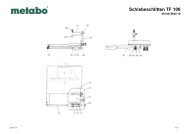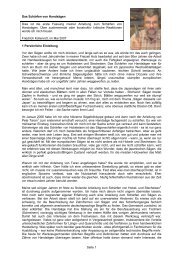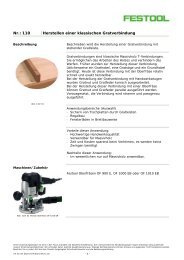KITY 2636 - Woodworking.de
KITY 2636 - Woodworking.de
KITY 2636 - Woodworking.de
Create successful ePaper yourself
Turn your PDF publications into a flip-book with our unique Google optimized e-Paper software.
The planer fence is continuously variably pivoting from 90°<br />
– 45°, where the pivoting segment must be loosened.<br />
Check each mo<strong>de</strong>l item with a protractor for dimension<br />
accuracy after every angle adjustment.<br />
Planer fence setup, Fig. 4<br />
Check the 90°/45° angle and set the cylin<strong>de</strong>r head screws<br />
M4x8.<br />
1 = Set screw 90° angle<br />
2 = Set screw 45° angle<br />
Attention!<br />
The planer fence must always remain firmly fixed.<br />
Fig. 5<br />
The clamping of the planer fence results from the exocentric<br />
lever.<br />
The planer fence is 260 mm adjustable over the planer.<br />
Attention!<br />
The planer fence must always remain firmly fixed.<br />
Planer shaft guard, Fig.6<br />
Screw on the planer shaft guard onto a hinged work table.<br />
The planer shaft guard can be <strong>de</strong>viated without a tool by<br />
pulling the exocentric lever upwards, swaying the shaft<br />
guard, pulling the exocentric lever back down.<br />
Fig. 7 + 8<br />
Attention: Never work with planer fences without the shaft guard.<br />
12 english<br />
Operating Instructions<br />
Preparing and setting up the machine<br />
• Changes, setup, measuring and cleaning work on the<br />
machine should only be done with the motor turned off.<br />
Disconnect the power plug and wait for the shutdown of<br />
the rotating tools.<br />
• After repairs and servicing, all protective and safety<br />
equipment must be immediately assembled.<br />
• Immediately exchange <strong>de</strong>fective planer knives (rifts or<br />
such). Monitor the knife change!<br />
• Check the effectiveness of the anti-kickback attachment<br />
before each operation. The gripper taper must have a<br />
sharp edge.<br />
• After repairs and servicing, all protective and safety warnings<br />
must be immediately mounted onto the machine.<br />
Thickness and work<br />
• Maximal planer shaft speed 4000 1/min<br />
• The planer shaft has been manufactured in accordance<br />
with DIN EN 847-1.<br />
• Begin the working operation only when the full speed is<br />
reached.<br />
• Keep the operator station free of shavings and wood<br />
waste.<br />
• Employ the extraction unit for extraction of shavings and<br />
wood dust. The velocity of flow of the extraction support<br />
must amount to min. 20 m/s.<br />
• Work only with sharpened planer knives. Dull planer<br />
knives increase the risk of relapse.<br />
• When processing long work pieces (longer than the feeding<br />
table) roll racks (optional equipment) should be employed.<br />
• Work: When dressing a work piece up to 100 mm thick,<br />
the planer shaft guard must cover the work piece and the<br />
planer shaft from above. If the work piece width is more<br />
than 100 mm, set the protective rails of the shaft guard<br />
to the width of the work piece. Make sure to put closed<br />
hands, with the thumb adjacent on the work piece.<br />
• Joining: The work piece is set against the work stopper.<br />
Set the rails of the shaft guard to the width of the work<br />
piece and leave on the table.<br />
• Dressing and joining of small cross sections (strips):<br />
When dressing the work piece, same as for work pieces<br />
up to 100 mm thick, it should be fed with spread out<br />
hands. When joining, push the work piece with both<br />
hands, with the fists closed, against the help stopper<br />
(optional equipment) and feed it through. The guard <strong>de</strong>vice<br />
is positioned near by and rests on the work piece.<br />
• Dressing and joining of small work pieces: When dressing,<br />
push the work piece with spread out hands to the<br />
work table and feed through with the pusher, using the<br />
right hand. The left hand sli<strong>de</strong>s over the guard <strong>de</strong>vice,<br />
as long as the work piece is on the table the weight of<br />
the left hand will shift onto the receiving table. When<br />
joining, push the work piece with the left hand, with the<br />
fist closed, against the help stopper and the table, then<br />
feed through with the pusher.<br />
• Chamfering or beveling: The work piece should be leaned<br />
against the work stopper. Set the protective rails of the<br />
shaft guard to the the width of the work piece and leave<br />
the piece on the table. Push the work piece with the left<br />
hand, with the fist closed, against the stopper and the<br />
receiving table and feed it through with the right hand<br />
closed.<br />
Beginning<br />
Before starting, observe the safety warnings. All guard and<br />
help <strong>de</strong>vices must be installed.<br />
Changes, setup, measuring and cleaning work on the machine<br />
should only be done with the motor turned off.<br />
Disconnect the power plug!<br />
Planer work – Chip removal, Fig. 9, Fig. 9.1<br />
The stock removal can be adjusted from 0 to 5 mm using the<br />
turning handle.<br />
Caution !<br />
Release the blocking handle Fig .9<br />
Read the <strong>de</strong>pth of the stock removal on the graduated ruler,<br />
adjust the table height using the turning handle Fig.9.1.<br />
Tighten the blocking handle Fig.9<br />
Planer work – Planer shaft guard, Fig. 7<br />
When dressing up to 100 mm work piece strength, the<br />
planer shaft guard must cover the work piece and the planer<br />
shaft from above. If the work piece width is more than<br />
75 mm, set the protective rails of the shaft guard to the<br />
width of the work piece. Make sure to put closed hands,<br />
with the thumb adjacent on the work piece.<br />
1 Surfacing angle gui<strong>de</strong><br />
2 Planer shaft guard<br />
Joining, Fig. 8<br />
Use the work stopper for this purpose, leave the planer<br />
shaft protector on the table and set the protective rails to<br />
the width of the work piece.<br />
Push the work piece against the planer stopper and then<br />
lead it over the planer shaft with both hands. As long as<br />
the board reaches high enough on the receiving table, put<br />
the left hand on it and shift it without interruption over the<br />
bla<strong>de</strong> shaft.






